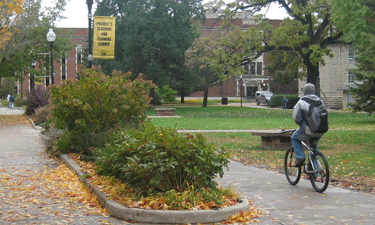 You might want to make sure you have some time on your hands before asking a bicycle enthusiast in the great Midwestern state of Wisconsin how they feel about their bike trails. Mountain bikers and “roadies” alike have a lot to gush about, and for good reason. Between a 10-county initiative to create a connected trails system and mountain biking groups dedicated to growing and improving recreational trails, Wisconsin has a lot going on.
You might want to make sure you have some time on your hands before asking a bicycle enthusiast in the great Midwestern state of Wisconsin how they feel about their bike trails. Mountain bikers and “roadies” alike have a lot to gush about, and for good reason. Between a 10-county initiative to create a connected trails system and mountain biking groups dedicated to growing and improving recreational trails, Wisconsin has a lot going on.
“The Dairy State” might not be the first state that comes to mind when you think about great biking and walking destinations. Certainly cities like Portland and Boulder are known for their bike-friendliness, but Wisconsin cities including Madison and Milwaukee have both made Bicycling magazine’s list of America’s Top 50 Bike-Friendly Cities with populations greater than 100,000. It’s not just the larger cities that are striving to be active-transportation friendly, though. Oshkosh — a city of just under 67,000 — is making great strides in creating a connected trails system for both bicyclists and pedestrians.
In 2011, Oshkosh adopted and approved a 20-year pedestrian and bicycle circulation plan steered by public, private and nonprofit groups. The plan includes 41 proposed improvements with on-street and off-street multiuse trails. The goal: enhancing overall transportation.
“Biking and walking are not just a recreational thing anymore — a lot of people are using those for transportation,” says David Buck, AICP, principal planner at City of Oshkosh.
The plan focuses on linking origins to destinations to get people where they are going and utilizes the trails within the city’s parks to create those links. Perhaps one of the most interesting aspects of the plan is the intention to link Oshkosh’s system with the larger regional bike plan.
“In our plan, our routes do extend beyond our city limits, and it was designed with the external trail and pathways being considered,” Buck says.
To accomplish this, Oshkosh is working with the East Central Wisconsin Regional Planning Commission (ECWRPC), which is working on a regional bike and pedestrian network plan. This plan includes 10 counties and is focused on connecting gaps between the municipalities and guiding them on best practices. ECWRPC also gathers plans from each community and puts them together to see how the biking and pedestrian plans in all 10 counties work together.
ECWRP also helps connect bicycle and pedestrian plans through the more rural areas where the local communities may not have these types of plans in place.
Mountain bikers in northeastern Wisconsin have cause for celebration too. Thanks to several enthusiastic biking groups and associations like the North East Wisconsin Trails (NEWT) International Mountain Bicycling Association (IMBA) chapter and Fox Valley Mountain Bikers, mountain bike trails are growing and expanding.
Matt Kletti, board member of both NEWT and Fox Valley Mountain Bikers, says, “IMBA is a huge resource for us. They provide resources, insurance, training and local government support to build and maintain trails and educate riders.”
According to Kletti, Fox Valley Mountain Bikers are also working on several trail projects alongside the local governments to grow and expand mountain biking throughout the region.
“The amount of energy in our area for mountain biking is insane,” Kletti says. “A little over a year and a half ago, it was just eight guys meeting at a coffee joint talking about bikes. Now we have over 600 likes on [Fox Valley Mountain Biker’s] Facebook.”
Both city planners and mountain bikers agree that education is key. The need for active transportation can be lost on more rural farm-folk, and many misconceptions still surround mountain biking including those who think it’s detrimental to the environment.
When it comes to education, the mountain biking groups and local parks departments play an important role. In Oshkosh, the parks department, along with managing and maintaining the trails, helps educate and encourage park goers to use the trails.
“They’re really a key component to the implementation of our plan — especially a lot of the nonphysical things like education,” Buck says.
On the mountain biking side of things, the local advocacy groups do a lot to educate both the public and community leaders.
“Luckily Wisconsin is really pushing bike-friendly stuff, so it’s getting easier to put trails in and connect them,” Kletti says.
Wisconsinites have a lot to look forward to when it comes to active transportation and recreation opportunities. Who knows — maybe they’ll switch from “The Dairy State” to “The Biking State.”
Learn more information about NEWT.
Roxanne Sutton is NRPA’s Senior Marketing and Communications Specialist.

